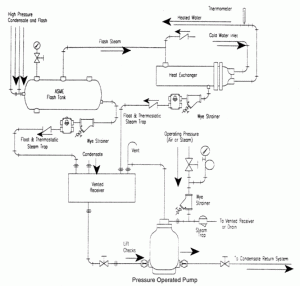 Many steam systems waste condensate. And the potential savings can be staggering. Considering the various pressures at which many steam systems operate, the inconvenient location of some steam traps, and the various lift requirements and back-pressures, it is not uncommon to see condensate leaks diverted to drain and /or steam traps discharging to the atmosphere. In effect, this practice results in thousands of dollars worth of heated, treated boiler feedwater being wasted. In turn, such operations are instead spending more on fuel to pre-heat makeup water and on chemicals to treat it.
Many steam systems waste condensate. And the potential savings can be staggering. Considering the various pressures at which many steam systems operate, the inconvenient location of some steam traps, and the various lift requirements and back-pressures, it is not uncommon to see condensate leaks diverted to drain and /or steam traps discharging to the atmosphere. In effect, this practice results in thousands of dollars worth of heated, treated boiler feedwater being wasted. In turn, such operations are instead spending more on fuel to pre-heat makeup water and on chemicals to treat it.
Condensate is boiler feedwater, and it is the most desirable type of boiler feedwater, in that it contains sensible heat and chemicals. If it is diverted to drain, cold, untreated water must be used to make up for it. This will of course need to be treated and preheated before being sent to the boiler. Conservative estimates for the cost of generating steam are approximately $4.00 to $6.00 per 1,000 lbs. Over a short period of time these costs add up. In most cases the payback for taking the steps to capture and return the condensate can be realized in short order.
There are many reasons why a trap may be diverted to atmosphere or drain. In many such cases there simply isn’t enough motive pressure to move the steam against the various back-pressures in the condensate system. Lift is often a problem. As a rule of thumb, 2 psig of motive steam pressure will lift one pound of condensate two feet. In a modulating temperature control system, the control valve can reduce steam flow to a point that the system is in a condition of stall. In this situation the condensate that should be returned to the boiler backs up into the heat exchanger, which reduces efficiency and will potentially cause damage. In such cases, maintenance personnel may find the easiest, most effective solution is to allow the steam trap to drain to the atmosphere. While this will solve the stall problem, it only causes another; specifically, wasted condensate.
To effectively solve condensate return problems, all factors of the system need to be considered. In this series we will look at sizing condensate return lines; understanding system stall; condensate pumping and recovery systems; and flash steam and flash steam recovery systems.
